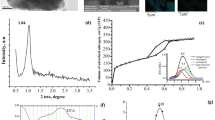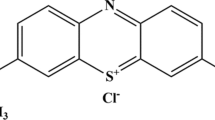Abstract
Methylene blue removal from aquatic environment using newly synthesized mesoporous carbon-glassy polyvinyl alcohol/silica gel composite. The mesoporous hybrid composite was characterized using several techniques, including IR, UV–Visible, TGA, surface morphological analyses images, EDX spectra and XRD. The removal method of methylene blue removal affected by factors such as increase in pH, temperature, time of adsorption, MB initial concentration and dosage of adsorbent was investigated. The elimination percentage of MB varied from 91 to 96% as the temperature increased from 293 to 323 K, respectively. The efficiency of MCPS is evident by giving a 91% removal rate for a 25 mg/L dye solution at 293 K compared to 44% for the glassy PVA/silica gel hybrid composite and 36% for mesoporous. The desorption efficiencies obtained for MCPS were 8%, 32% and 6.5% for H2O, HCl and acetic acid, respectively. The findings were processed utilizing two adsorption isotherm models in addition to kinetic models. The kinetic analysis results suggested that the pseudo-first-order model was consistent with the experimental findings. The Langmuir isotherm model was considered to be an adequate model for the uptake process. The highest capacities for uptake at 293, 303, 313 and 323 K were 13.55, 16.59, 19.81 and 25.01 mg/g, respectively. The thermodynamic parameters explained that MB removal was spontaneous and endothermic with ΔHo = 26.24 kJ/mol. From the low desorption efficiencies, we confirmed the uptake of MB by MCPS via physisorption.














Similar content being viewed by others

Availability of data and materials
All the data that support the findings of this study are displayed in this manuscript.
References
M.M. Arukkani, P.R. Divakaran, A.B. Nitin Nikamanth, K.J. Thelly, J. Polym. Environ. 27, 1007 (2019)
A. Murugesan, M. Loganathan, P. SenthilKumar, DVN. Vo, Sustain. Chem. Pharmacy; 21, 100406 (2021)
M. Loganathan, Arya S. Raj , A. Murugesan , P. Senthil Kumar , Chemosphere; 304, 135332 (2022)
A. Murugesan, P. Mahendran, J. Polym. Environ.; 28, 2393( 2020)
K.C. Bedin, I.P.A.F. Souza, A.L. Cazetta, L. Spessato, A. Ronix, V.C. Almeida, J. Mol. Liq. 269, 132 (2018)
Z. Duan, Y. Li, M. Zhang, H. Bian, Y. Wang, L. Zhu, D. Xia, J. Clean. Prod. 256, 120308 (2020)
M. Zebardast, A. Fallah Shojaei, and K. Tabatabaeian, Iran. J. Catal. 8, 297 (2018).
B.H. Hameed, A.A. Ahmad, J. Hazard. Mater. 164, 870 (2009)
J. Zheng, C. Cheng, W.-J. Fang, C. Chen, R.-W. Yan, H.-X. Huai, C.-C. Wang, CrystEngComm 16, 3960 (2014)
Jiang, D, et al., Process Saf. Environ. Prot. 172, 1132 (2023)
Ying-jie Song , Hai-chao Li , Zi-wei Xiong , Long Cheng , Miao Du , Zun qi Liu , Jun Li , De-qiang Li , Diamond and Related Materials 136, 2023,109918.
J. Dou, D. Gan, Q. Huang, M. Liu, J. Chen, F. Deng, X. Zhu, Y. Wen, X. Zhang, Y. Wei, Int. J. Biol. Macromol. 136, 476 (2019)
Z. He, Q. Huang, L. Mao, H. Huang, M. Liu, J. Chen, F. Deng, N. Zhou, X. Zhang, Y. Wei, Sci. Commun. 37, 100278 (2020)
H. S. KusumaUyios, O. Aigbe, K. E. Ukhurebor, R. B. Onyancha, B. Okundaye, I. Simbi, O. Monday Ama, H. Darmokoesoemo, B. Ayu Widyaningrum, O. Adelaja Osibote , V. Aizebeoje Balogun ,Results in Chemistry, 5 ,2023 , 100778.
F. Deng, J. Liang, G. Yang, Q. Huang, J. Dou, J. Chen, Y. Wen, M. Liu, X. Zhang, Y. Wei, J. Environ. Chem. Eng. 9, 104872 (2021)
I.M. Arafa, M.M. Fares, A.S. Barham, Eur. Polym. J. 40, 1477 (2004)
F.W.G.F.J.M. Zeigler, Silicon-Based Polymer Science, A Comprehensive Resource, 1st edn. (American chemical society, Washington, DC., 1989)
S. Rattanapan, J. Srikram, P. Kongsune, Energy Procedia 138, 949 (2017)
M.M. Kamel, I.H. Alsohaimi, M.S. Alhumaimess, H.M.A. Hassan, M.S. Alshammari, M.Y. El-Sayed, Res. Chem. Intermed. 47, 925 (2021)
H.P.S. Khalil, M. Jawaid, P. Firoozian, U. Rashid, A. Islam, H.M. Akil, J. Biobased Mater. Bioenergy 7, 708 (2013)
T. Unugul, F. Ugur Nigiz, Water Air Soil Pollut. (2020) 231:538.
R. Guo, J. Guo, F. Yu, D.D. Gang, Microporous Mesoporous Mater. 175, 141 (2013)
W. Małgorzata, V. Bogatyrow, I. Ostolska, K. Szewczuk, K. Karpisz, A. Terpiłowski, W. Nosal, Adsorption 22, 417 (2015)
L. Meili, P.V. Lins, C. Zanta, J.I. Soletti, L.M.O. Ribeiro, C.B. Dornelas, T.L. Silva, M.G.A. Vieira, Appl. Clay Sci. 168, 11 (2019)
F. Zhou, K. Li, F. Hang, Z. Zhang, P. Chen, L. Wei, C. Xie, RSC Adv. 12, 1885 (2022)
P. Senthil Kumar, M. Palaniyappan, M. Priyadharshini, A. M. Vignesh, A. Thanjiappan, P. Sebastina Anne Fernando, R. Tanvir Ahmed, and R. Srinath, Environ. Prog. Sustain. Energy 33, 87 (2014).
L. Chen, Y. Li, S. Hu, J. Sun, Q. Du, X. Yang, Q. Ji, Z. Wang, D. Wang, Y. Xia, J. Exp. Nanosci. 11, 1156 (2016)
O. S. Amuda, A. O. Olayiwola, A. O. Alade, A. G. Farombi, and S. A. Adebisi, J. Environ. Prot. (Irvine,. Calif). 5, 1352 (2014).
M.T. Amin, A.A. Alazba, M. Shafiq, Sustainability 7, 15302 (2015)
L. Liu, S. Fan, Y. Li, Int. J. Environ. Res. Public Health 15, 1321 (2018)
U.A. Guler, M. Ersan, E. Tuncel, F. Dügenci, Process Saf. Environ. Prot. 99, 194 (2016)
A.A. Inyinbor, F.A. Adekola, G.A. Olatunji, Water Resour. Ind. 15, 14 (2016)
K.V. Kumar, V. Ramamurthi, S. Sivanesan, J. Colloid Interface Sci. 284, 14 (2005)
V. Vadivelan, K.V. Kumar, J. Colloid Interface Sci. 286, 90 (2005)
Z. Shahryari, A.S. Goharrizi, M. Azadi, Int. J. Water Resour. Environ. Eng. 2, 16 (2010)
S. Hashemian, M.K. Ardakani, H. Salehifar, Am. J. Anal. Chem. 4, 1 (2013)
Acknowledgements
This work was funded by the Deanship of Scientific Research at Jouf University under Grant No. (DSR-2021-03-0118). The authors extend their appreciation to the Deanship of Scientific Research at Jouf University for funding this work through research grant No (DSR-2021-03-0118).
Funding
Deanship of Scientific Research at Jouf University, Grant No. (DSR-2021–03-0118).
Author information
Authors and Affiliations
Contributions
MMK, MYE-S, HMAH and IA wrote the main manuscript text, and AMA and SFA-F prepared figures. All authors reviewed the manuscript.
Corresponding author
Ethics declarations
Competing interests
The authors declare that they have no conflicts of interest.
Ethical approval
This article does not contain any studies with human participants or animals performed by the authors.
Additional information
Publisher's Note
Springer Nature remains neutral with regard to jurisdictional claims in published maps and institutional affiliations.
Rights and permissions
Springer Nature or its licensor (e.g. a society or other partner) holds exclusive rights to this article under a publishing agreement with the author(s) or other rightsholder(s); author self-archiving of the accepted manuscript version of this article is solely governed by the terms of such publishing agreement and applicable law.
About this article
Cite this article
Kamel, M.M., El-Sayed, M.Y., Alsohaimi, I.H. et al. Applicability of mesoporous carbon-glassy polyvinyl alcohol/silica gel hybrid composite to remove methylene blue from aqueous solution. Res Chem Intermed 49, 3659–3679 (2023). https://doi.org/10.1007/s11164-023-05041-3
Received:
Accepted:
Published:
Issue Date:
DOI: https://doi.org/10.1007/s11164-023-05041-3



